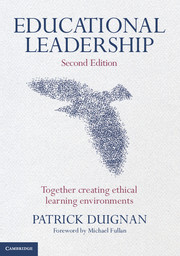Book contents
- Frontmatter
- Foreword
- Contents
- Acknowledgements
- INTRODUCTION AND OVERVIEW
- CHAPTER 1 THE CHANGING AND CHALLENGING CONTEXT FOR EDUCATIONAL LEADERS
- CHAPTER 2 KEY MACRO CHALLENGES FOR EDUCATIONAL LEADERS
- CHAPTER 3 KEY MICRO CHALLENGES FOR EDUCATIONAL LEADERS
- CHAPTER 4 LEADERSHIP CHALLENGES AS TENSIONS
- CHAPTER 5 A FRAMEWORK FOR ANALYSING ETHICAL TENSIONS
- CHAPTER 6 VISION-INSPIRED LEADERSHIP AND ETHICAL DECISION-MAKING
- CHAPTER 7 BUILDING A COLLECTIVE ETHIC OF RESPONSIBILITY FOR LEADERSHIP IN SCHOOLS
- CHAPTER 8 AUTHENTIC LEADERS USE THE POWER OF PRESENCE, AUTHENTIC RELATIONSHIPS, AND INFLUENCE FIELDS
- CHAPTER 9 AUTHENTIC LEADERS HELP CREATE INNOVATING, DEEP, RICH LEARNING ENVIRONMENTS
- CHAPTER 10 FORMING CAPABLE AND AUTHENTIC LEADERS: TRANSFORMATIONAL LEARNING APPROACHES
- References
- Index
CHAPTER 9 - AUTHENTIC LEADERS HELP CREATE INNOVATING, DEEP, RICH LEARNING ENVIRONMENTS
Published online by Cambridge University Press: 05 June 2012
- Frontmatter
- Foreword
- Contents
- Acknowledgements
- INTRODUCTION AND OVERVIEW
- CHAPTER 1 THE CHANGING AND CHALLENGING CONTEXT FOR EDUCATIONAL LEADERS
- CHAPTER 2 KEY MACRO CHALLENGES FOR EDUCATIONAL LEADERS
- CHAPTER 3 KEY MICRO CHALLENGES FOR EDUCATIONAL LEADERS
- CHAPTER 4 LEADERSHIP CHALLENGES AS TENSIONS
- CHAPTER 5 A FRAMEWORK FOR ANALYSING ETHICAL TENSIONS
- CHAPTER 6 VISION-INSPIRED LEADERSHIP AND ETHICAL DECISION-MAKING
- CHAPTER 7 BUILDING A COLLECTIVE ETHIC OF RESPONSIBILITY FOR LEADERSHIP IN SCHOOLS
- CHAPTER 8 AUTHENTIC LEADERS USE THE POWER OF PRESENCE, AUTHENTIC RELATIONSHIPS, AND INFLUENCE FIELDS
- CHAPTER 9 AUTHENTIC LEADERS HELP CREATE INNOVATING, DEEP, RICH LEARNING ENVIRONMENTS
- CHAPTER 10 FORMING CAPABLE AND AUTHENTIC LEADERS: TRANSFORMATIONAL LEARNING APPROACHES
- References
- Index
Summary
As discussed in chapter 2, currently there appears to be a tension between two educational paradigms with different emphases. One of these paradigms tends to emphasise the centrality of standards, accountability, testing and student achievement as measures of school performance, while the other focuses more on improving pedagogy and, especially, enhancing the conditions for learning and learning outcomes more generally. The focus in this chapter is on an approach to educational leadership that aims at improving the quality of teaching, learning, learning environments, and student outcomes in schools. Authentic educational leaders at all levels promote and support the core values of schooling; that is, quality teaching and learning, and thereby better prepare students for a productive, contributing and fulfilling life.
In this chapter, recent meta-analysis research is discussed and critiqued, especially with regard to conclusions about how teachers and other educational leaders influence student achievement. Then the implications of seeing schools as complex learning communities, and leadership as an influence relationship operating through influence fields, are explained. Drawing on recent OECD research and commentary on educational leadership and innovative learning environments, as well as on other literature and the author's research findings, the nature of deep, rich and engaging learning environments for teachers and students is described and ways are considered as to how such learning environments can be created and sustained, with special emphasis on the forms of leadership that will best accomplish all of this.
- Type
- Chapter
- Information
- Educational LeadershipTogether Creating Ethical Learning Environments, pp. 164 - 196Publisher: Cambridge University PressPrint publication year: 2012



